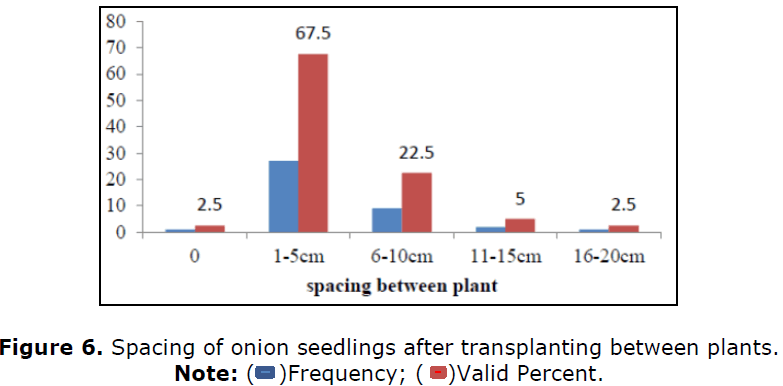Review Article - (2021) Volume 9, Issue 4
Review on nitrogen phosphorus sulfur fertilizers on productivity of onion (Allium cepa L.) under irrigated farming system
Desta Tesfaye1 and Israel Zewudi2*2Department of Agriculture and Natural Resource, Mizan-Tepi University, Mizan-Aman, Ethiopia
Abstract
Onion is an important vegetable crop, which has produced worldwide including of Ethiopia for its daily uses and economic benefits. Under the scarcity of irrigation water, the need to use the available water economically and efficiently is unquestionable. Deficit irrigation improves water use efficiency, by maintaining soil moisture content below optimum level throughout the growing season. The objective of this study was to study the effect of onion yield response to irrigation level during low and high sensitive growth stages and bulb quality under semi-arid climate conditions. An experiment was conducted for three consecutive seasons to investigate the effect of water stress imposed at different growth stages on bulb yield and water productivity of onion (Allium cepa L.). This was mainly related to low adoption of onion production package. The objective of this research was to assess the reasons for low adoption of the recommended onion production package by farmers in the study area. The major constraints of onion production in the study area were shortage of irrigation water, high costs of irrigation equipment’s, shortage of genuine spare parts and accessories, shortage of pesticides and their adulteration, limited supply of improved onion seeds and lack of storage facilities, lack of skills and knowledge, high incidence of diseases and insect pests and weak extension and credit services. Results of Nitrogen, Phosphorus and Sulfurs rate trial revealed that most of growth and yield parameters of onion were significantly influenced by Nitrogen, phosphorus and Sulfurs fertilizer rates. The result of the study indicated that majority of farmers are used to the onion production package however they applied either above or below the research recommendation.
Keywords
Allium cepa L., Water productivity, Fertilizer rate
Introduction
Onion is considered as one of the most important vegetable crops produced on small scale in Ethiopia. It also occupies an economically important place among vegetables in the country. The area under onion is increasing from time to time mainly due to its high profitability per unit area and ease of production, and the increases in small scale irrigation areas. The crop is produced both under rain fed in the “Meher” season and under irrigation in the off season. Onion (Allium cepa L.) is considered as one of the most important and major irrigated vegetable crops produced on a large scale in Ethiopia. High water productivity may be more profitable to the farmer than high crop yield. This is because the water saved when deficit irrigation is applied becomes available to irrigate more land since the latter is not a limiting factor. The irrigator aims to increase water use efficiency by reducing the amount of water at irrigation or by reducing the number of irrigation (Tasisa, 2021).
In the Ambo area, irrigation is applied on a routine basis, inadequate management of irrigation water and absence of scheduling has been an important limiting factor to the onion and other crop production (Tasia, 2021). Food insecurity has been the problem of Ethiopia for many years and recurrent droughts have been one of the major problems during the past three decades. The occurrence of drought in most parts of the country is usually caused by insufficient rainfall to support the seasonal water requirements of the rain-fed crop production so generally food security is more sufficient then irrigation of water in the crop is more excess (Gebeyehu, 2021).
In Ethiopia, onions grow in different agro-climatic regions mainly due to considerably increasing its importance in the daily diet of Ethiopians. It is also one of the most essential condiments, vegetable and cash crops in Ethiopia (Lchi et al., 2020). Onion production in Ethiopia is affected by different factors among which no balanced fertilizer application, lack of proper soil fertility management practices, limited awareness of growers on soil fertility management are the major ones problem of Northwestern Zone of Tigray, Ethiopia (Gebretsadik and Dechassa, 2016; Negasi et al., 2017). Farmers in the northwestern zone of Tigray mostly use blanket recommendation of 200 kg ha-1 DAP and 150 kg ha-1 Urea for onion production. They rarely use organic manure for onion production on small scale in gardens and near their homestead (Lchi et al., 2020).
Onion (Allium cepa L.), also known as the bulb onion and common onion, is the most widely cultivated species of the genus Allium, and belongs to the family Alliaceae (Khalid, 2019). Onion is one of the most important monocotyledonous, cross-pollinated and cool season bulb vegetable crops produced throughout the world (Muluneh, 2016). The low productivity could be attributed to the limited availability of quality seeds and associated production technologies used, among the others. Onion (Fikre Mulugeta and Olani Nikus, 2010) is an important horticulture and commercial crop categorized under root crops. Onion is a vegetable crop widely cultivated in the world. The climatic requirements for onion production are tropical, high altitudes or semiarid of temperature range of 15°C to 20°C, annual rain fall of 1000-1500 mm, and altitude of 1200 asl are averagely suitable for onion production. The best growing altitude so far known in Ethiopia is between 700-1800 m.a.s.l. Besides altitude which has an indirect bearing on climate, onion production is affected by temperature, rainfall and soil. It grows well under mild climatic without extreme heat or cold or excessive rain fall (Fikre Mulugeta and Olani Nikus, 2010). Regard to soil type fertile sandy and silt loam or peat soil and PH of 6.0-8.0 are suitable for onion production. Among six released varieties of onion Bombay red and Adama red varieties are widely adopted in different part of Ethiopia.
Onion has economically important role in Ethiopia. The country has enormous potential to produce the crop throughout the year both for domestic use and export market. Ever since the crop is distributed to different parts of the country, it is widely cultivated as a source of income by many farmers in many parts of the country as a whole. Nitrogen (N) and phosphorus (P) are often referred to as the primary macronutrients because of the probability of plants being deficient in these nutrients and the large quantities taken up from the soil relative to other essential nutrients (Guesh, 2015). Nitrogen plays an important role for optimum yield of onion and is found to be essential to increase the bulb size and yield.
The use of onion is not limited to any climate or associated with any nationality. The product is produced for both consumption and market. Under deficit irrigation, crops are deliberately allowed to sustain some water deficit and yield reduction. The irrigator aims to increase Water Use Efficiency (WUE) by reducing the amount of water at irrigation or by reducing the number of irrigation (Nikolaou et al., 2020).
Literature Review
Objective
The general objective of the study was to review on onion productivity practices and to evaluate the effects of different rates of Nitrogen, Phosphorus and Sulphur fertilizer rates.
To determine the economical optimum rate of Nitrogen, Phosphorus and Sulphur fertilizer for onion productivity.
Botany and origin
Onion (Allium cepa L.) belongs to the family Alliaceae and the genus Allium (Khalid, 2019). The genus contains of about 750 species, among which onion, Japanese bunching onion, leeks and garlic are the most important once (Robinowith and Currah, 2002). Onion is herbaceous biennial monocot but cultivated as an annual crop for bulb production. For seed production onion is cultivated as biennial crop, in the first season bulbs are formed while flower stalks and seeds are developed in the second season (Muluneh, 2016).
Distribution and importance of onion
Onions are one of the most ancient vegetable crops under cultivation. Onion has been widely distributed to various countries of the world. Onion is probably cultivated in almost all countries of the tropical Africa including Ethiopia (Muluneh, 2016). In Ethiopia, onion is relatively a recent introduction. Onion is by far the most important of all bulb crops cultivated commercially in most parts of the world (Muluneh, 2016). It is primarily used as flavoring agent in preparing various dishes. The major climatic factors which influence the onion crop water needs are: temperature, humidity and wind speed.
Soil and climatic requirement of onion
Onion is adapted to a wide range of temperatures and relatively frost tolerant. Best production is obtained when cool temperatures prevail over an extended period of time that permit considerable foliage and root development before bulbing starts. Bulb formation is favored by relatively high temperatures (Muluheh, 2016). An optimum temperature for the production of onion ranges from 18-27°C. Seed production is also an important practice in onion production. Onion has specific temperature requirements for seed and bulb production. In Ethiopia, day temperatures ranging from 20-26°C and night temperatures of 11-15°C are ideal for bulb production, whereas temperatures between 9-17°C are favorable for onion seed production since these temperatures induce flower stalk development in onion. Onion grows well in altitude between 700-18000 meters above sea level (Muluneh, 2016).
Irrigation, potential and development in Ethiopia
There is clear evidence that, climate change has altered hydrological cycles and weather patterns, resulting into increase of intensity and frequencies of extreme weather conditions, with significant impacts on the agricultural sector (Ketema, 2019). However, the total irrigable land potential in Ethiopia is 5.3 Mha with existing technologies and water resource including ground water and rainwater harvesting. Irrigation potential using only surface water potential from the whole river basin in the country is estimated to 3.73 Mha. Based on the irrigable land potential, only 12% is under irrigation now a day. This indicates that there are potential opportunities to boost the amount of irrigated land (Ketema, 2019).
Water scarcity
Water scarcity is commonly defined as a situation when water availability in a country or in a region is below 1000 m3/person/year. However, many regions in the World experience much more severe scarcity, living with less than 500 m3 per person per year, which could be considered severe water scarcity. The threshold of 2000 m3 per person per year is considered to indicate that a region is water stressed. Desalination, non- renewable groundwater resources and wastewater reuse compensate renewable water scarcity supplementing the renewable resource (Ketema, 2019). Water scarcity is among the major problems that are challenging many societies in different part of the world. In these areas, available water resource is not sufficient for production of food and alleviating hunger and poverty. Moreover, population growth is larger than the capability for a sustainable use of natural resources. In Ethiopia, water scarcity is majorly associates with economic considerations. Hence, despite abundance in some parts, the country is highly water-scarce due to lack of water control infrastructure (Seleshi et al., 2007). However, high population increase drives the country to water scarcity.
The major water source for crop production in Ethiopia is rainfall. However, the trend of rainfall amount is decreasing and the distribution is erratic especially in arid and semiarid areas of the country. To minimize water scarcity in crop production and utilization of water resource in Sustainable manner, different technologies and management options are being under use. In different part of the country, rainfall shows high variability from year to year with minimum and maximum temperatures increasing both seasonally and annually. According to Solomon et al. (2015) at Mieso area, the year-to-year coefficient of variation is 25%.Therefore, the area is highly vulnerable to moisture stress even during the major crop-growing season of the year.
Water productivity
Concept of water productivity in agricultural production systems is focused on producing more food with the same water resources or producing the same amount of food with less water resources. Water Productivity (WP) mainly refers to the ratio between output derived from water use and the water input (Ketema, 2019). It is widely believed that an increase in agricultural water productivity (WP) is the key approach to mitigate water shortage and to reduce environmental problems in arid and semiarid regions. In the dry areas, water, not land, is the most limiting resource for improving agricultural production. Maximization of yield per unit of water (WP), and not yield per unit of land (land productivity), is, therefore, a better strategy for dry farming systems (Ketema, 2019).
In crop production system, WP is used to define the relationship between crops produced and the amount of water involved in crop production, expressed as crop production per unit volume of water. The common measure that is emerging to measure water productivity is kilograms of yield produced per meter cube of water. The yield can be quantified in terms of wet or dry yield, nutritional value or economic return. Research results confirm that Deficit Irrigation (DI) on growth stage is successful in increasing water productivity for various crops without causing severe yield reductions (Dirirsa et al., 2017). Water-use efficiency (WUE) is generally defined in agronomy as the ratio of crop yield (usually economic yield) to water used to produce the yield. WUE is a measure of the productivity of the water consumed by the crop (Ketema, 2019).
Response of onion to nitrogen application
Roles of nitrogen in onion nutrition and growth: Onion being among the high nitrogen demanding vegetables, its productivity depends on use of optimum fertilizer rates and if not adequately fertilized, considerable yield losses are apparent. Among all nutrients, nitrogen is the most important and also the most limiting to crop production. Efficient N use is important for the economic sustainability of cropping systems (Muluneh, 2016). Mineral fertilizers are one of the principal factors that materially set up onion growth and production. Onion plants take up large amounts of the three primary nutrients, i.e. nitrogen, phosphorus and potassium (Kandil et al., 2013).
The description of the Study Area in agro- climatic condition of the area is wet with 811 mm mean annual rain fall and it is a uni-modal rainfall pattern with extended rainy season from March to September. However, the peak rainy season is from July to August. The mean annual maximum and minimum temperatures are 23.1 and 9.9°C, respectively. The coldest month is December whereas; May is the hottest month (Nimon et al., 2021).
Climate: The average annual rainfall in the area is 824.9 mm. The climate of the area is characterized as semi-arid with uni-modal low and erratic rainfall pattern. Summer season have got more rainfall about 67.4% of the total rainfall of the area occurs from June to September, with peak month of July and August. The mean maximum and minimum monthly rainfall is 204.2 and 9.6 mm occurs in the month of August and November, respectively (Figure 1).
Generally this graph of rainfall is maximum then reference of evapotranspiration (ETO) also minimum or decrease from June to September. The mean maximum temperature varies from 26.3 to 31.0°C while the mean minimum temperature varies from 10.4 to 16.4°C, with the average of 21.3°C.
Climate characteristics: Each crop has certain environmental requirements. To attain the highest yield (potential yield), a crop must be grown in an environment that meets the requirements. The main climatic element determinant to crop growth and yield includes rainfall, temperature, solar radiation, and wind speed (Tasisa, 2021).
The pattern of the seasonality of rain in the Ambo area is determined by analyzing the mean monthly rainfall ratio with that of the rainfall module as rainfall amount. This rainfall amount is used to utilize the availability of water to determine the amount and frequency of irrigation. It also used how plants survive the period without rain, frequency of irrigation, and scheduling of irrigation, i.e., how much water to apply and when to irrigate (Figure 2).
Temperature is an important element of weather in crop production. The maximum temperature usually occurs during daytime and minimum during the night. Maximum temperatures, during the day, are important factors to determine potential evapotranspiration. Likewise, minimum temperatures are also useful to identify the occurrence of frost, which consequently decreases the production and productivity of the crop. About eighty (80%) of the total rainfall of the study area occurs from May to September with its peak in the months of July and August. The remaining months receive less rainfall. As transpiration is greatly reduced, leaf temperature is greater than air temperature because of radiation absorbed by the leaf. In agreement with the present result, Disket et al. (2017).
Discussion
In the Gubalafto district Days to 70% physiological maturity. The number of days required to reach 70% physiological maturity of onion was highly significantly (p<0.01) influenced by the effect of NPS blended fertilizer rates and varieties. However, the interaction of blended fertilizer rate and varieties had no significant (p>0.05) influence on days to 70% maturity. The earliest days to physiological maturity were recorded from control treatment, which was statistically on par with the application of NPS blended fertilizer at 81.34 kg ha-1. Plants that received 325.36 kg ha-1 NPS fertilizer rate matured late which were statistically on par with those plots fertilized with 244.02 kg ha-1 NPS rate (Figures 3 and 4).
The possible reason for the highest days of maturity at 325.36 kg ha-1 NPS could be because nitrogen application extends the vegetative growth period of plants which in turn resulted in delayed maturity. The result of the present work is in agreement with the work of (Alemu and Derbew, 2020) who revealed that the highest rate of nitrogen fertilizer extended the vegetative growth phase of onion.
On the other hand, the highest NPS blended fertilizer rate (406.70 kg ha-1) shortened days to maturity. It might be due to the effect of phosphorus, sulfur, and boron which accelerates maturity and ripening when applied at an optimum rate.
Regardless of NPS fertilizer rates, Bombay Red matured at 116.22 days while Adama red matured at 122.33 days after transplanting. This indicates that Bombay Red matured 6 days earlier than Adama Red in the Figure 4. The variation in maturity among onion varieties might be due to their genetic differences and the response of varieties to the environment. This finding is consistent with the results of who reported that Bombay Red matured significantly earlier than Adama Red (Alemu and Derbew, 2020).
Spacing
The researcher asked the farmers about the applications of spacing when they are transplanting their onion seedlings from seed bed to their field. Based on this (30%) of farmers responded that they use spacing between rows from 21-30 cm while 27.5% of the farmers used 11-20 cm. 25% and 12.5% of the respondents used from 31-40 cm and 41- 50 cm respectively. Few of the farmers (2.5%) also used 1-10 cm. However, 2.5% of the farmers do not used spacing (Figure 5).
According to the key informant interview, the reasons for not using recommended spacing by farmers was that, spacing required additional labour and capital. On the other hand, they needed to have denser plantation to compensate for death of some seedlings (Mahilet, 2012).
They also believe that denser plantation would enable to obtain better yield. In addition to this, medium size onion bulb is more marketable than big size onion bulb. Due to these reasons the farmers do not follow the research recommendation.
Figure 6 shows spacing of onion seedlings after transplanting between plants. 67.5% of the respondents used 1-5 cm while (22.5%) of the farmers used 6-10 cm. The rest (5%) and (2.5%) of the farmers used 11-15 cm and 16-20 cm between plants respectively. But (2.5%) of the respondents do not apply spacing between plants (Mahilet, 2012).
Conclusion
To improve productivity of onion by the application of respective fertilizers, Farmer’s knowledge must be strengthened. Mineral fertilizers must play an important part in improving agricultural productivity of onion in farming systems. Farmers participating were able to differentiate types of fertilizer, and understood rates of application and the roles of respective fertilizers in nutrient supply. But, notions were broadly generated by unsteady yield responses when fertilizers were used across different fertility gradients, association with high cost (especially if recommended rates were to be applied), association of fertilizer use with hybrids and certain crops, historical factors, among other main aspects. Strengthening fertilizer knowledge must be tailored within existing, albeit imperfect, systems of crop and animal husbandry. Perceptions of Farmer’s cannot be changed by promoting more fertilizer use alone, but may require a more basic approach that, for example, encourages farmer experimentation and practices to improvements in soil fertility to levels that boost food security in Africa will require substantial increases in enhance soil properties such as carbon build-up in impoverished local soils.
Acknowledgements
Foremost, I would like to express my sincere gratitude to my adviser Dr Israel zewudi for the continuous support he provided me throughout the period of my study with great affability, and immense knowledge. His guidance, comments, suggestions and insightful advice helped me at all stages of my review paper work and during the writing of my review.
References
- Alemu M, Derbew B (2020). Effect of blended (NPS) fertilizer rate on growth and yield of onion (Allium cepa. L.) varieties at Gubalafto District, North-Eastern Ethiopia. Agbir. 36(2):33-38.
- Dirirsa G, Abraham W, Tilahun H (2017). Effect of deficit irrigation at different growth stages on Onion (Allium Cepa L.) production and water productivity at Melkassa, Central Rift Valley of Ethiopia. Acad. Res. J. Agric. Sci. Res. 5(5):358-365
- Disket D, Parshant, Bakshi, Stanzin, Dorjey, Preeti, Choudhary, Kiran, Kour, Mahender, Singh (2017). Effect of deficit irrigation scheduling on yield and quality of kinnow mandarin fruits. Int. J. Curr. Microbiol. App. Sci, 6(7), 261-269.
- Fikre M, Olani N (2010). Onion seed production techniques a manual for extension agents and seed producers, Assela, Ethiopia. 8-9.
- Gebeyehu T (2021). Regulated deficit irrigation and Onion (Allium Cepa L) yield response on water productivity. 10(1):1-7.
- Gebretsadik K, Dechassa N (2016). Agronomic and economic evaluation of nitrogen fertilizer rates and intra row spacing on growth and bulb yield of Onion (Allium cepa L.) under rainfall condition. Environ. 6(21):1-10
- Guesh T (2015). Growth, yield, and quality of Onion (Allium Cepa L.) as influenced by intra row spacing and nitrogen fertilizer levels in central zone of Tigray, Northern Ethiopia.
- Ketema T (2019). Effect of soil moisture stress on onion (allium cepa l) production and water productivity at Melkassa in the central rift valley of Ethiopia Hawassa University Hawassa, Ethiopia.
- Khalid M (2019). The Most Widely Cultivated of Bulb Onion and Common Onion. CRC Press, Boca Raton, Florida.
- Kandil AA, Sharief AE, Fathalla FH (2013). Effect of organic and mineral fertilizers on vegetative growth, bulb yield and quality of onion cultivars. Crop. Prod. 2(3):91-100.
- Lchi A, Neqasi T, Tesfa B (2020). Growth and yield of onion (Allium cepa L.) as affected by farmyard manure and nitrogen fertilizer application in Tahtay Koraro District, Northwestern Zone of Tigray, Ethiopia. Vegetos, 33(4):617-627.
- Mahilet Y (2012). Adoption of onion production package by smallholder farmers in the Dugda District in East Shoa Zone of Oromia Regional State, Ethiopia. Sl: sn.
- Muluneh N (2016) Assessment of Onion production practices and effects of Nitrogen: Phosphors: Sulfur fertilizers rates on yield and yield components of Onion (Allium cepa l.) under irrigated farming system in Dembiya District, Amhara Region, Ethiopia.
- Negasi T, Nigussie D, Kebede W, Lemma D, Abuhay T (2017). Effect of Integrated Nitrogen, Phosphorus, and Farmyard Manure on Post-harvest Quality and Storability of Onion (Allium Cepa L.). J. Postharv. Tech. 5(4):25-37
- Nikolaou G, Neocleous D, Christou A, Kitta E, Katsoulas N (2020). Implementing sustainable irrigation in water-scarce regions under the impact of climate change. Agron. 10(8):1120.
- Nimon F, Fikadu GM, Dasta T, Demsi FL (2021). Evaluation of Seed Production and quality performance of Onion (Allium Cepa L.) varieties at Kulumsa in Arsi Zone South East Ethiopia. J. Agri. Crop.
- Robinowith HD, Currah L (2002). Alliums crop sciences: Recent advances. CABI Publishing International. London UK. 515.
- Seleshi B, Aster D, Mekonnen L, Loiskandl W, Mekonnen A, Tena A (2007). Water Resources and Irrigation Development in Ethiopia. IWMI.
- Solomon T, Kindie T, Girma M (2015). Analysis of rainfall and temperature variability to guide Sorghum (Sorghum bicolar) production in Miesso areas, Eastern Ethiopia. Int. J. Sus. Agric. Res. 2(1):1-11.
- Tasisa TT (2021) Onion yield response to irrigation level during low and high sensitive growth stages and bulb quality under semi- arid climate conditions of Western Ethiopia. Cog. Food. Agric. 7(1):1859665.
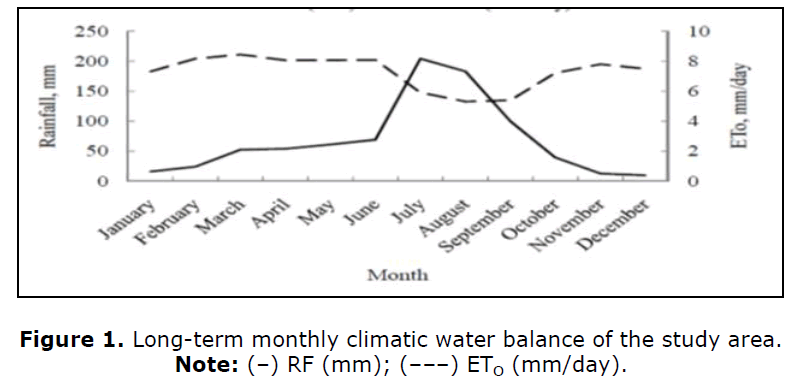
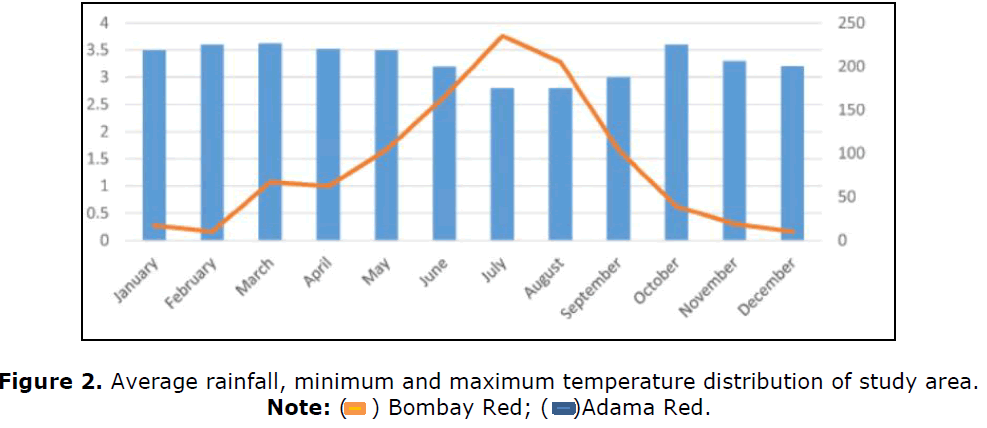
 Adama Red.
Adama Red.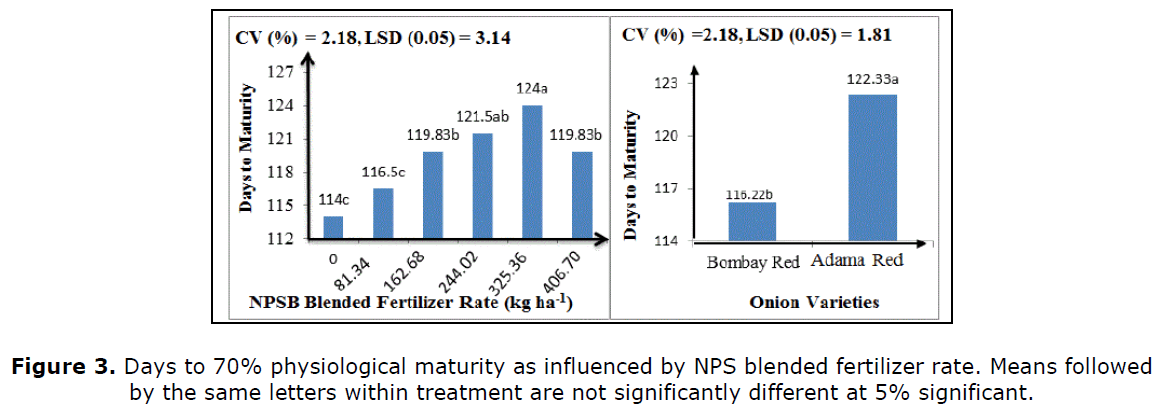
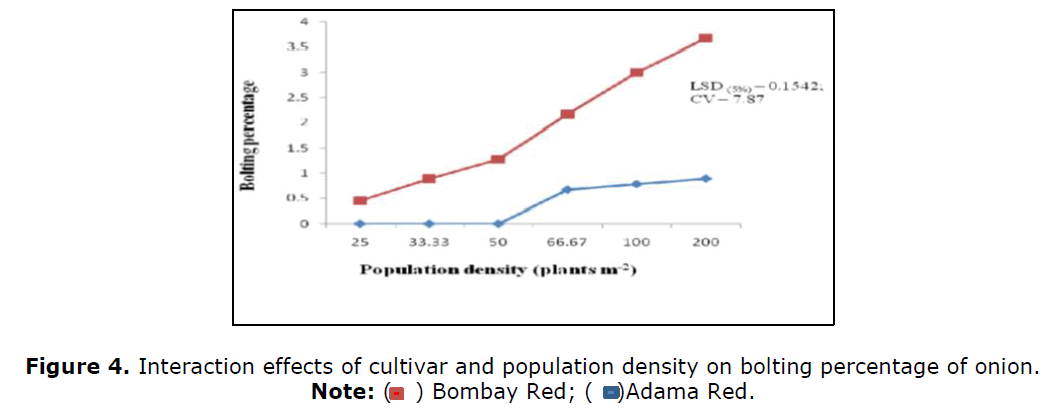
 Adama Red.
Adama Red.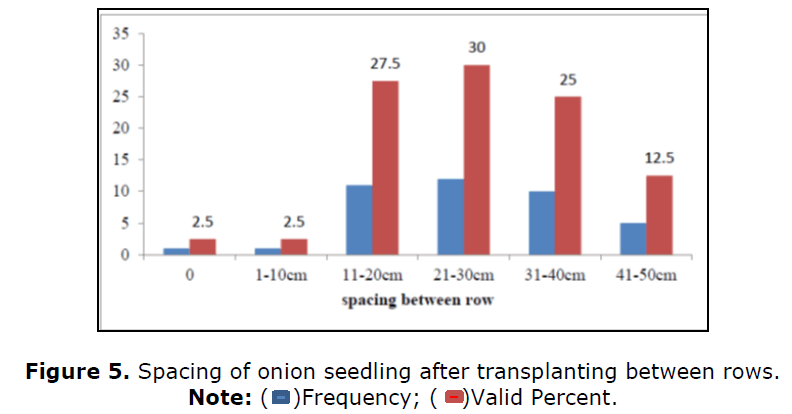
 Valid Percent.
Valid Percent.